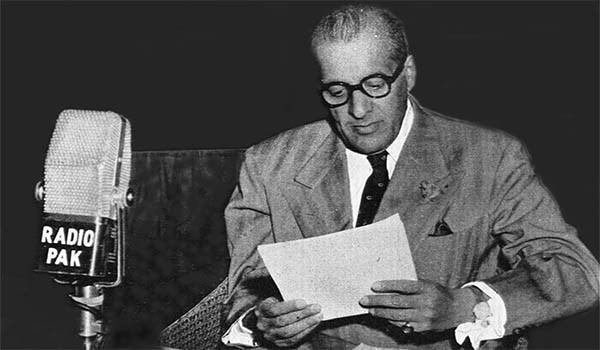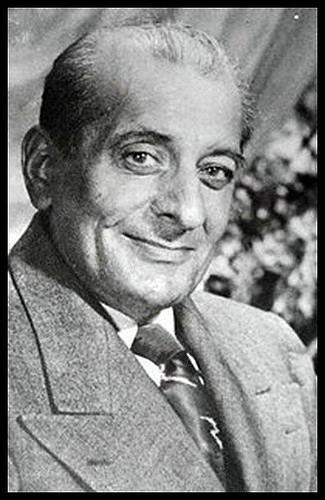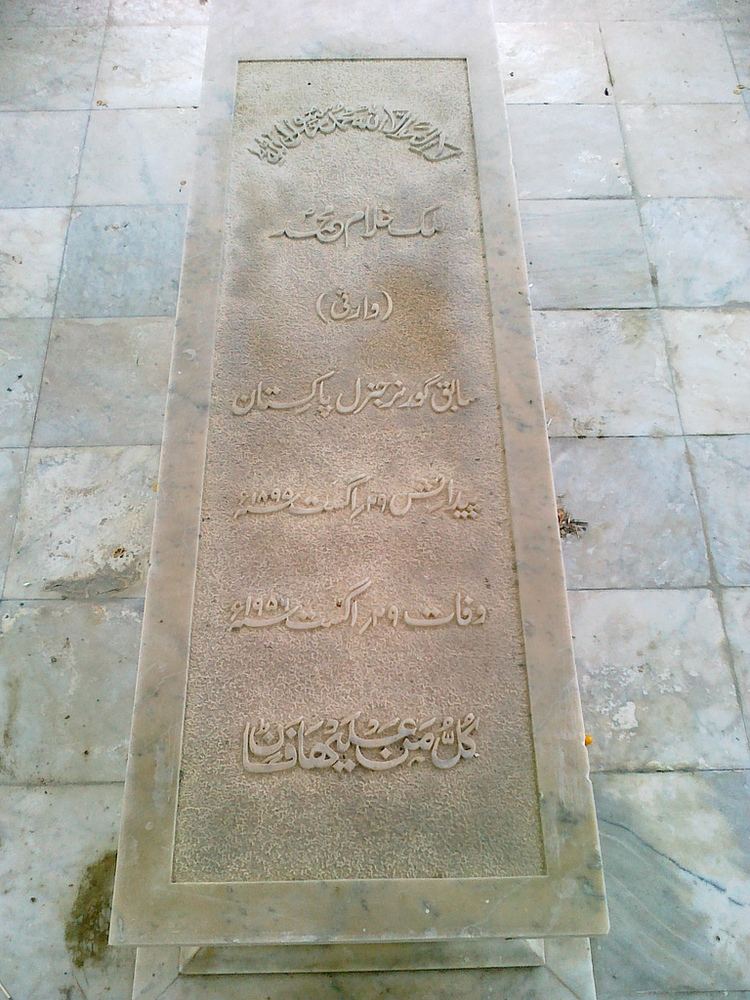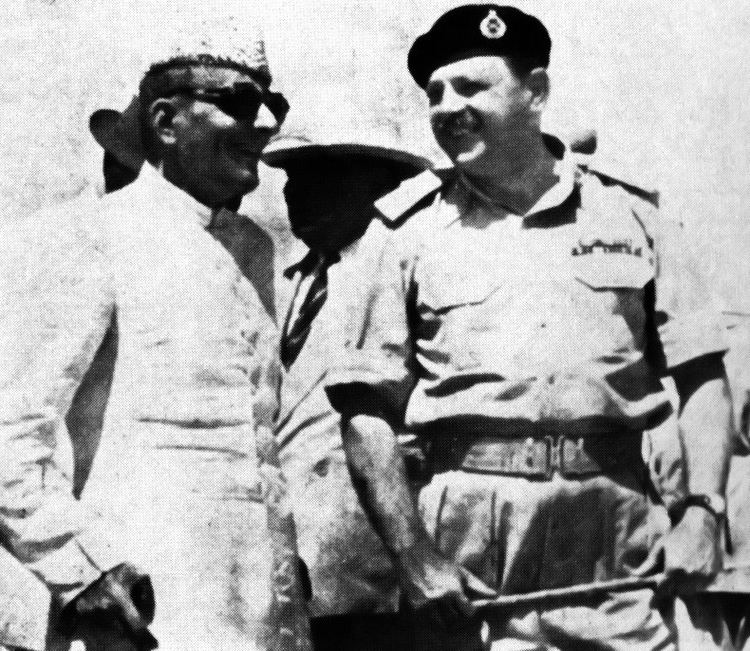Monarch George VIElizabeth II Name Malik Muhammad | Preceded by Position established Succeeded by Iskander Mirza | |
 | ||
Prime Minister Liaquat Ali KhanKhawaja Nazimuddin Organizations founded Mahindra & Mahindra, Mahindra Group People also search for Jagdish Chandra Mahindra, Anand Mahindra, Kailash Chandra Mahindra | ||
Malik ghulam muhammad top 10 facts
Sir Malik Ghulam Muhammad (Urdu: ملک غلام محمد;b. 20 April 1895 – 29 August 1956), , was a Pakistani financier who served as the third Governor-General of Pakistan, appointed in this capacity in 1951 until being dismissed in 1955 due to health conditions.
Contents
- Malik ghulam muhammad top 10 facts
- What happened when grave of Malik Ghulam Muhammad Was opened
- Family background and education
- Civil service and business interests
- Finance Minister 194751
- Governor General 1951 55
- References

Educated at the Aligarh Muslim University (AMU), he joined the Indian Civil Service as a chartered accountant at the Indian Railway's account service before being promoted to join the Ministry of Finance under Liaquat Ali Khan in 1946. After the independence of Pakistan as a result of Partition of India in 1947, he joined the Liaquat administration as the country's first Finance Minister where he helped draft the first five-year plans to alleviate the national economy of Pakistan.

Following the assassination of Prime Minister Liaquat Ali Khan in 1951, he was appointed Governor-General by Khwaja Nazimuddin who took over the government as Prime Minister. Nationwide violence in the aftermath of the language movement in Dacca and religious riots in Lahore led to him dismissing Nazimuddin's administration and later Prime Minister Muhammad Ali Bogra using the reserve powers to restore control of the Law and order in Pakistan in 1953–54. In 1955, he was forcefully dismissed from the post of Governor-General by then-Interior Minister Iskander Ali Mirza due to the worsening of his health conditions. Afterwards, he fought a brief battle with his illness and then died in 1956.
His personal image is viewed negatively by Pakistan's historians, criticized for giving rise to political intrigue, undermining the civilian control of the military by authorizing the Martial law in Pakistan, and devaluing nascent democratic norms by sacking Constituent Assembly of Pakistan.

What happened when grave of Malik Ghulam Muhammad Was opened
Family background and education

Malik Ghulam Muhammad was born in a suburban neighborhood near Mochi Gate in Lahore, Punjab, India, to a middle class but wealthy family on 20 April 1895.

He hailed from a Punjabi Pathan family who traced their roots Kakazai tribe of Pashtuns and spent his childhood in the Walled City of Lahore and thus the impact of pure Lahori culture was very much visible on his personality. After completing his schooling in Lahore, he went to Aligarh in Uttar Pradesh to attend the MOA College of the Aligarh Muslim University (AMU), and was a roommate of Nazir Ahmed, a physicist and a bureaucrat. At AMU he gained a BA degree in accountancy.
Civil service and business interests
After graduating from AMU, he joined the Indian Civil Service and posted at the Audit and Accounts Service to provide accountancy for the Indian Railway Accounts Service. He earned a reputation as an able and competent accountant for the Indian Railway which eventually led to be served as a member in the Indian Railway Board before becoming the Controller of General Supplies and Purchase of the Indian Railways. His serves as a professional accountant was recognized by the British government who honoured him by appointed Malik as a Companion of the Order of the Indian Empire (CIE) in 1941.
In 1945, he helped co-found the Mahindra and Mohamed Steel Company together with steel industrialists, JC Mahindra and KC Mahindra where Muhammad served the company's chartered accountant. In 1945–47, the company initially registered as the Mahindra & Mohammad, and started the licensed production of the Willys jeeps in Mumbai as Muhammad looked after the company's revenue and finances.
After World War II, he was asked by Nawab of Bahawalpur, Lord Sadeq Mohammad Khan V to represent him at the Round Table Conferences, and during this time, he began formatting political relations with the Liaquat Ali Khan. He later served as advisor to the Nizam of Hyderabad, but left to join the Ministry of Finance in 1946. In the 1946 Birthday Honours, the last honours list in which Indian civil servants were honoured, he received a knighthood.
Finance Minister (1947–51)
In 1946–47, Muhammad left Mahindra & Mahindra and joined the Ministry of Finance as a Cabinet Secretary under Finance Minister Liaquat Ali Khan, assisting him in drafting and preparing India's first union budget.
After witnessing the Partition of India in 1947, he decided to acquire the citizenship of Pakistan and permanently settled in his native city, Lahore, on 14 August 1947. He was brought up in the Liaquat administration when Prime Minister Liaquat Ali Khan appointed him as country's first Finance Minister. He presented the first budget and submitted the draft of the First Five-Year Plans in 1948.
In 1949, Muhammad invited leaders of the Muslim world to the International Islamic Economics Organization in Pakistan, where he emphasised the idea of a Muslim economic bloc. During this time, he survived the fatal attack of paralysis that made him unable to talk or move effectively and began suffering with poor health conditions.
Governor-General (1951-55)
As early as 1951, Prime Minister Liaquat Ali Khan had made a decision of removing Finance Minister Muhammad due to his continuing worsening health conditions. However, the decision was not taken due to the assassination of Prime Minister Liaqat Ali Khan in October 1951. Governor-General Khwaja Nizamuddin nominated him in his capacity while taking control over the government as the Prime Minister, appointing his own cabinet.
In 1953, he represented Pakistan as head of state at the Coronation of Elizabeth II in Westminster Abbey alongside with the Governors-General from Canada, Australia, New Zealand, South Africa and Ceylon. Upon returning to Pakistan, he witnessed the agitation caused by the language movement in Dacca in East Pakistan, and the series of violent anti-Ahmadiyyah riots in Lahore, Punjab in Pakistan. Both events led him to use the reserve powers awarded by the Government of India Act of 1935 against Prime Minister Nazimuddin, effectively dismissing his administration only to be replace with diplomat M. A. Bogra.
In 1954, the Constituent Assembly made legislative attempts to try changing the 1935 act to establish checks and balances on the Governor-General's powers. In response, Muhammad again dismissed the Constituent Assembly, an action that was challenged in the Sindh High Court by Maulvi Tamizuddin, the Speaker of the Assembly. The Sindh High Court's Chief Justice Sir George Constantine ruled the Governor-General's decision illegal, but the ruling was overturned by Supreme Court of Pakistan, led by Chief Justice Muhammad Munir, in a split decision.
Historians consider this action the beginning of viceregal politics in Pakistan, in which the military and civil bureaucracy, not elected officials, would gain increasing influence over the country's policymaking.
During this time, his health began to deteriorated as paralysis spread in his whole body, forcing him to take a leave of absence to seek treatment in the United Kingdom in 1955. In his capacity, he appointed Interior Minister Iskander Mirza as acting Governor-General but Mirza dismissed him from his post in order to take his place, supported by the Constituent Assembly's legislators. On 29 August 1956, Malik Sir Ghulam Muhammad died and was buried in Lahore, with very few people attending his funeral.
